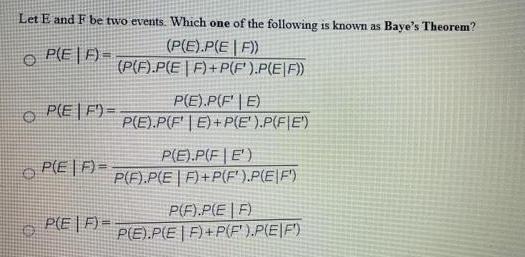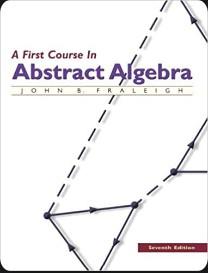Question
Let E and F be two events. Which one of the following is known as Baye's Theorem? P(EF) (P(E).P(EF)) (P(F).P(EF)+P(F).P(EIF)) O O 0 P(EF)=

Let E and F be two events. Which one of the following is known as Baye's Theorem? P(EF) (P(E).P(EF)) (P(F).P(EF)+P(F).P(EIF)) O O 0 P(EF)= P(E|F)= P(E).P(FE) P(E).P(F' E)+ P(E' ).P(FIE) P(E).P(FE') P(F).P(EF)+P(F').P(EF) P(F).P(E | F) P(E).P(E | F)+P(F').P(EIF) P(EF)= 9
Step by Step Solution
3.40 Rating (163 Votes )
There are 3 Steps involved in it
Step: 1
The detailed answer for the above question is provided below Solution By definition ...
Get Instant Access to Expert-Tailored Solutions
See step-by-step solutions with expert insights and AI powered tools for academic success
Step: 2

Step: 3

Ace Your Homework with AI
Get the answers you need in no time with our AI-driven, step-by-step assistance
Get StartedRecommended Textbook for
A First Course In Abstract Algebra
Authors: John Fraleigh
7th Edition
0201763907, 978-0201763904
Students also viewed these Computer Network questions
Question
Answered: 1 week ago
Question
Answered: 1 week ago
Question
Answered: 1 week ago
Question
Answered: 1 week ago
Question
Answered: 1 week ago
Question
Answered: 1 week ago
Question
Answered: 1 week ago
Question
Answered: 1 week ago
Question
Answered: 1 week ago
Question
Answered: 1 week ago
Question
Answered: 1 week ago
Question
Answered: 1 week ago
Question
Answered: 1 week ago
Question
Answered: 1 week ago
Question
Answered: 1 week ago
Question
Answered: 1 week ago
Question
Answered: 1 week ago
Question
Answered: 1 week ago
Question
Answered: 1 week ago
View Answer in SolutionInn App



